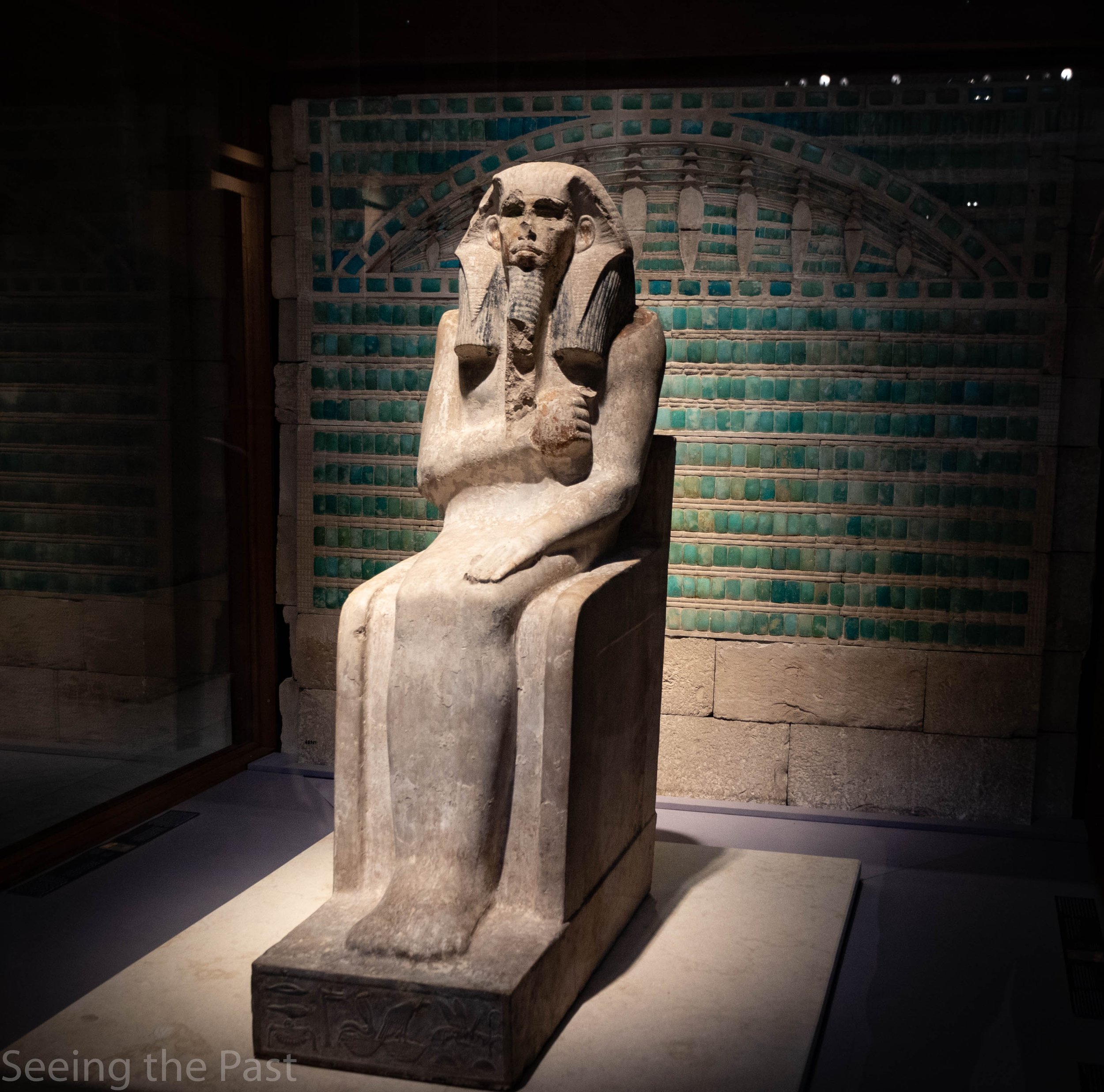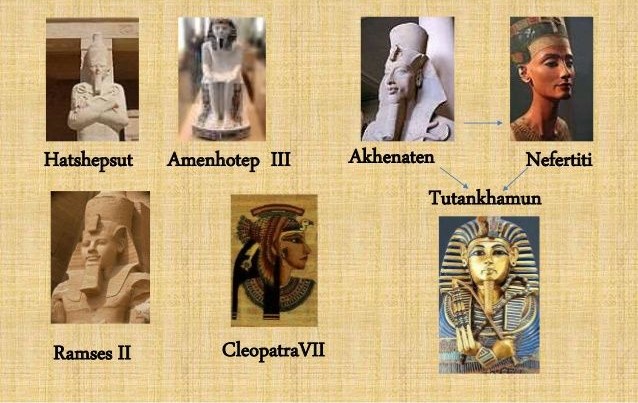I often reflect on the storied beginnings of Ancient Egypt’s dynastic age, and it is Narmer who demands my first acknowledgement. Ascribed as the founding father of the First Dynasty, he masterminded the cardinal unification of Upper and Lower Egypt. His reign, hovering around the 31st century BCE, symbolizes the dawn of an epoch that sculpted the contours of history.
I find it essential to discuss the Narmer Palette when examining the symbols of his rule. Discovered in Hierakonpolis, the palette is more than an ancient Egyptian artifact; it is a historical document carved in stone. It provides me, and indeed any curious scholar, evidence of Narmer’s might and celebrated victory that led to a united kingdom.
More than just a political leader, Narmer was a cultural pioneer establishing traditions that would echo through millennia. His legacy is palpable in his establishment of the city of Memphis, setting the blueprint for pharaonic architecture and governance. Moreover, Narmer’s unification narrative permeates Egyptian lore and asserts his place as a pivotal figure in transforming the land of the Nile into a synchronized civilization.
Narmer sowed the seeds of innovation and prosperity that would burgeon under the rule of future pharaohs such as Djoser, whose advancements in architectural splendor stand as a timeless homage to the ambitions incited by early pharaonic rule. As we segue into the era of Djoser, we see the tangible realizations of a vision initiated by Narmer come to fruition in the shape of the Step Pyramid at Saqqara – a monumental leap in the ancient world’s architectural prowess.
Architectural Triumphs: Djoser and The Step Pyramid

When you hear of the pyramids of Egypt, the first image that likely comes to mind is the iconic, smooth-sided pyramids at Giza. However, these architectural marvels had their origins in earlier, more experimental structures. The Step Pyramid at Saqqara, commissioned by Pharaoh Djoser, marked a pivotal point in Egyptian architecture.
Djoser’s reign, a fertile period of about two decades in the Old Kingdom, set the stage for the architectural innovations that would forever define the skyline of ancient Egypt. Serving as perhaps the centrepiece of Djoser’s legacy, the Step Pyramid is not only a monumental grave but is also recognized as one of the oldest substantial stone buildings in the world.
Overseen by the architectural genius Imhotep, who was later deified for his accomplishments, the pyramid’s tiered design was unprecedented. Each layer, or ‘step,’ was intended to help the pharaoh ascend to the heavens and join the gods. It laid the groundwork for future pharaohs’ monuments and showcased the advanced understanding of construction and design during Djoser’s rule.
The significant shift from traditional mastaba tombs to a more ambitious pyramid structure reveals much about the society’s advancements in both engineering and religious beliefs. It’s during Djoser’s era that we start to see the transition from the earthly presence of the pharaoh to an exalted, divine status that would be echoed in the tombs of later rulers.
While not as grandiose or as well-known as the later pyramids of Giza, Djoser’s Step Pyramid remains an enduring symbol of the innovative spirit of Ancient Egypt. It’s a testament to their reverence for the afterlife and a mark of respect for a ruler they believed would continue to guide them from the stars.
This reverence and pursuit of immortality is a theme that will be thoroughly exemplified in the next pharaoh’s legacy as well. As we transition from the Step Pyramid of Saqqara, let’s focus on one of the most awe-inspiring achievements of ancient civilization: the Great Pyramid of Giza, a crowning achievement of Pharaoh Khufu.
Khufu (Cheops): Mastermind Behind the Great Pyramid

When I evoke the image of the Great Pyramid of Giza, it’s not just an ancient structure that comes to mind; it’s a symbol of the remarkable capability of human ingenuity. It’s also a lasting tribute to the pharaoh Khufu, or Cheops, as he is also known, who ruled during what many consider to be the zenith of the Old Kingdom of Egypt.
Now, what about this pyramid makes Khufu so timeless? It is, after all, one of the Seven Wonders of the Ancient World. Engineers and historians alike are still piecing together how this massive structure, with its precise dimensions and alignment with the cardinal points, was constructed with the tools and knowledge available some 4,500 years ago. The Great Pyramid is an upwards journey into the sky, a colossal undertaking of labor and resources that tells us Khufu was a pharaoh of incredible ambition and authority.
But Khufu’s legacy certainly goes beyond limestone blocks; it delves into the heart of Egyptian culture. Despite there being very few surviving records about his reign outside the pyramid itself, Khufu’s monumental project solidified his image as a god-king and set a precedent for future pharaohs and their quest for immortality.
Scholars have worked tirelessly to understand more about Khufu and the time he lived in. It’s fascinating to think about the complex system of governance that must have been in place. Imagine the administrative skill required to command the workforce, the logistics involved in sourcing the stone, and the depth of architectural prowess needed to build something so enduring.
It’s not all about grandeur, though. Critics have often pointed to the Great Pyramid as a sign of autocracy, suggesting that such projects were immensely burdensome on the nation’s resources and its people. Nevertheless, it’s a powerful testimony to the fact that Khufu left the world something that has withstood the test of time, both physically and metaphorically.
His place in history firmly cemented, Khufu was succeeded by other rulers who also left their mark on the Egyptian empire. Most notably, there was a queen who rose to the occasion and challenged gender norms to become one of ancient Egypt’s most revered leaders. She was Hatshepsut and her story, coming next, is quite extraordinary.
The Female Pharaoh: Hatshepsut’s Prosperous Reign

Hatshepsut shatters the historical mold as a woman who ascended the throne of Egypt, not just as a queen, but as a pharaoh in her own right. Her reign, roughly from 1479 to 1458 BCE, stands out as a period of peace and economic prosperity. Hatshepsut wasn’t Egypt’s first female ruler, but she is certainly its most famous, taking on all the traditional roles and titles of a male pharaoh.
She did more than don a false beard; she launched ambitious building projects that have withstood the sands of time. Her mortuary temple at Deir el-Bahari, nestled into the cliffs on the west bank of the Nile, serves as an architectural marvel of the ancient world. Often referred to by its Arabic name, the ‘Northern Monastery’, its elegance belies its monumental scale and offers insight into her reign and legacy.
Beyond her architectural accomplishments, Hatshepsut reinforced Egypt’s economic strength through extensive trade expeditions, notably to the land of Punt. These ventures brought back precious goods such as incense, ivory, and myrrh, which were highly prized in Ancient Egypt. Such initiatives swelled the state treasury and solidified Egypt’s position as a trade center of the ancient world.
Hatshepsut’s prosperous reign set the stage for the unprecedented expansion under her successor and stepson, Thutmose III. Despite Thutmose III’s attempts to erase her from history, his own legacy as a pharaoh was, in many ways, built upon the stable platform that Hatshepsut had established during her time on the throne.
Thutmose III: The Expansionist Pharaoh

When I think about Thutmose III, I remember a ruler whose military acumen and strategic brilliance earned him the title ‘Napoleon of Egypt’. He ascended to the throne as a co-regent with his stepmother, Hatshepsut, and later ruled alone, steering Egypt through a period of unprecedented territorial expansion.
Thutmose III is known for the Battle of Megiddo, an exemplary display of his warfare prowess that set a standard for military tactics for centuries. It wasn’t just the incredible number of victories that defined his campaign, but the meticulous planning and execution that secured him triumph after triumph.
Beyond his military conquests, he was a pharaoh who had a profound impact on the Egyptian Empire’s wealth and capacity. The spoils and tributes from his campaigns significantly contributed to the empire’s prosperity. The numerous temples he constructed or added to, including the impressive complex at Karnak, stand as a testament to this.
His mummy, which rests in the Valley of the Kings, tells its own story of a life dedicated to the might and splendor of Egypt. Thutmose III’s mummy, alongside the records chronicling his military strategies, reminds us of the skills and tactics that made Egypt a force to be reckoned with.
While Thutmose III solidified Egypt’s reputation as a formative military power, another pharaoh was setting the stage for a major cultural and religious shift that would challenge Egypt’s traditional structure. Akhenaten, Thutmose III’s successor but three pharaohs later, made decisions that would forever change the religious landscape of Ancient Egypt.
Akhenaten: The Revolutionary Monotheist

Imagine stepping into a time when all of Egypt worshiped an array of deities, and then one leader turned it all upside down. That leader was Akhenaten. He not only challenged the Egyptian polytheistic tradition but dared to redefine it.
Akhenaten’s reign marked the dramatic shift to monotheism with exclusive worship of the sun disk, Aten. This was unheard of at a time when gods and goddesses numbered in the hundreds. His religious movement was more than a change in worship; it was a cultural shockwave.
During his reign, Akhenaten moved Egypt’s capital from Thebes to the new city of Akhetaten, modern-day Amarna. The city was meticulously planned to align with his new religious order. Art and literature took on a more realistic style, breaking from the rigid norms of prior periods.
The impact of his religious reforms spread beyond temples and shook the foundation of centuries-old institutions. Akhenaten’s focus on Aten had significant implications for the powerful priestly class, whose influence was heavily rooted in the established pantheon.
Akhenaten’s reign eventually came to an end, and with it, his religious revolution. After his death, traditional worship was restored, and subsequent rulers attempted to erase his legacy. Ironically, attempts to remove him from history only fueled future fascination.
The legacy of Akhenaten’s religious rebellion set the stage for his successor, the young Tutankhamun. Tutankhamun would inherit a kingdom rife with complexities born from Akhenaten’s decisions.
Cleopatra VII: The Last Pharaoh and Her Storied End

We close our exploration of Egypt’s illustrious rulers with Cleopatra VII, whose name is synonymous with the end of an era. She was a sovereign engulfed in the seismic shifts of power, a leader whose life was threaded with political sagacity and legendary dalliances that continue to captivate the imagination of the world.
Cleopatra’s intelligence and shrewd political maneuvers cannot be overstated. She maintained her grip on power in a time when women rulers were exceptional, forging strategic relationships with Julius Caesar and Mark Antony. Through these alliances, she attempted to safeguard Egypt’s political autonomy amidst the rising tide of Roman dominance.
But the tide was against her. The death of Cleopatra marked more than the loss of a pharaoh; it signified the fall of Ancient Egypt as an independent power, transitioning into a province under the vast Roman Empire. Her passing ended the millennia-spanning lineage of pharaonic rule, ushering in a new world order.
With the conclusion of Cleopatra’s reign, we are reminded of the transient nature of power and the enduring legacy of leadership. These rulers—Narmer, Djoser, Khufu, Hatshepsut, Thutmose III, Akhenaten, Tutankhamun, Ramses II, and Cleopatra—each contributed uniquely to the tapestry of history that defines Ancient Egypt. Their accomplishments, whether in monumental architecture, military conquests, spiritual innovations, or maintaining Egypt’s sovereignty, left an indelible mark and teach us timeless lessons of ingenuity, resilience, and ambition.
As modern explorers of history, we carry forward the stories of these formidable individuals, ensuring that their influence endures as firmly as the pyramids they built and the legacies they left behind.

